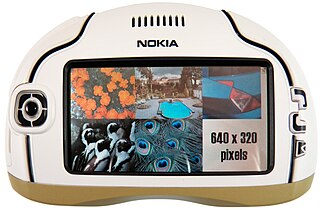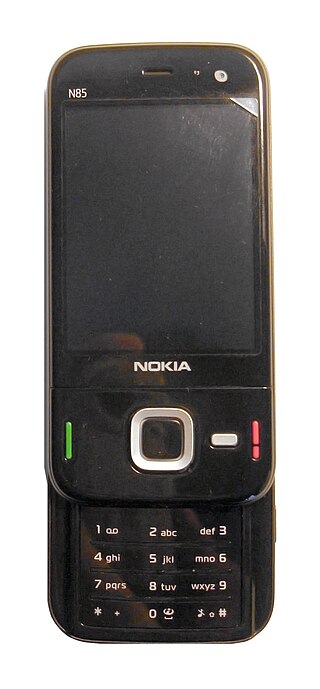Related Research Articles

Nokia Corporation is a Finnish multinational telecommunications, information technology, and consumer electronics corporation, established in 1865. Nokia's main headquarters are in Espoo, Finland, in the greater Helsinki metropolitan area, but the company's actual roots are in the Tampere region of Pirkanmaa. In 2020, Nokia employed approximately 92,000 people across over 100 countries, did business in more than 130 countries, and reported annual revenues of around €23 billion. Nokia is a public limited company listed on the Helsinki Stock Exchange and New York Stock Exchange. It is the world's 415th-largest company measured by 2016 revenues according to the Fortune Global 500, having peaked at 85th place in 2009. It is a component of the Euro Stoxx 50 stock market index.
DVB-H is one of three prevalent mobile TV formats. It is a technical specification for bringing broadcast services to mobile handsets. DVB-H was formally adopted as ETSI standard EN 302 304 in November 2004. The DVB-H specification can be downloaded from the official DVB-H website. From March 2008, DVB-H is officially endorsed by the European Union as the "preferred technology for terrestrial mobile broadcasting". The major competitors of this technology are Qualcomm's MediaFLO system, the 3G cellular system based MBMS mobile-TV standard, and the ATSC-M/H format in the U.S. DVB-SH now and DVB-NGH in the future are possible enhancements to DVB-H, providing improved spectral efficiency and better modulation flexibility. DVB-H has been a commercial failure, and the service is no longer on-air. Ukraine was the last country with a nationwide broadcast in DVB-H, which began transitioning to DVB-T2 during 2019.

Series 40, often shortened as S40, is a software platform and application user interface (UI) software on Nokia's broad range of mid-tier feature phones, as well as on some of the Vertu line of luxury phones. It was one of the world's most widely used mobile phone platforms and found in hundreds of millions of devices. Nokia announced on 25 January 2012 that the company has sold over 1.5 billion Series 40 devices. It was not used for smartphones, with Nokia turning first to Symbian, then in 2012–2017 to Windows Phone, and most recently Android. However, in 2012 and 2013, several Series 40 phones from the Asha line, such as the 308, 309 and 311, were advertised as "smartphones" although they do not actually support smartphone features like multitasking or a fully fledged HTML browser.

The Nokia 7710 is a smartphone developed by Nokia and announced on 2 November 2004. It was the first Nokia device with a touchscreen, and first Nokia branded device with 2:1 aspect ratio display. The 7710 is based on the Nokia 7700 which was never released. It is Nokia's only smartphone to run the Series 90 interface atop Symbian OS v7.0s.
The Nokia N92 is a smartphone part of the multimedia Nseries. It was announced on November 2, 2005 and was the world's first mobile phone with an integrated DVB-H tuner. As a result, Nokia marketed it as a phone for watching TV on the go. It featured the same swivel design as the N90. It runs on Symbian OS v9.1 and the S60 3rd Edition interface.
Mobile television is television watched on a small handheld or mobile device, typically developed for that purpose. It includes service delivered via mobile phone networks, received free-to-air via terrestrial television stations, or via satellite broadcast. Regular broadcast standards or special mobile TV transmission formats can be used. Additional features include downloading TV programs and podcasts from the Internet and storing programming for later viewing.

XpressMusic was a brand name for a line of Nokia mobile phones that were specially designed for music playback. All of the XpressMusic handsets came with expandable MicroSD memory slots and dedicated music keys, so these phones could also be used as MP3 players. The XpressMusic range was launched in September 2006 to compete with the Walkman brand series from Sony Ericsson. Except for one device, being the Nokia 3250 XpressMusic edition, all XpressMusic models were marketed with the 5000 series prefixes.

The Nokia N95 is a smartphone produced by Nokia as part of their Nseries line of portable devices. Announced in September 2006, it was released to the market in March 2007. The N95 ran S60 3rd Edition, on Symbian OS v9.2. It has a two-way sliding mechanism, which can be used to access either media playback buttons or a numeric keypad. It was first released in silver and later on in black, with limited edition quantities in gold and purple. The launch price of the N95 was around €550.

The Nokia N73 is a smartphone announced by Nokia on 2006 & Music Edition 2007, as part of the Nseries and started shipping on 15 July. The N73 succeeded the N70 and packed in numerous multimedia features. It features a 3.2 megapixel autofocus camera, a front camera, a then-large 2.4-inch display, and stereo speakers, all in a relatively slim and pocketable size and form. It runs on Symbian v9.1.

The Nokia 7700 is a smartphone produced by Nokia, announced in October 2003 but never released. It was produced as a prototype unit between 2003-2004. It was expected to be the first smartphone running the Series 90 GUI on Symbian OS and Nokia's first pen-based device, intending to compete against handsets like Sony Ericsson P800. At announcement Nokia dubbed it a "media device."
Mobile TV Format is a colloquial and collective name for technology standards set out for broadcasting TV services to mobile devices, mostly mobile handsets for now. Currently, there are four prevalent formats known as DMB, DVB-H, OneSeg and MediaFLO. As of December 2007, ITU approved T-DMB, DVB-H, OneSeg and MediaFLO as the global standard for real-time mobile video and audio broadcasting. Thus far, none of the four formats has secured a dominant position in the global market, except in their respective home markets.

The Nokia N96 is a discontinued high-end smartphone announced by Nokia on 11 February 2008 at the Mobile World Congress in Barcelona as part of the Nseries line. The N96 runs Symbian OS v9.3. It is compatible with the N-Gage 2.0 gaming platform and has a DVB-H TV tuner and AV output.

The Nokia N97 is a high-end smartphone introduced on 2 December 2008 by telecommunications manufacturer Nokia as part of its Nseries and released in June 2009 as the successor to the Nokia N96 phone. The N97 was Nokia's second S60-based touchscreen phone, after the Nokia 5800 XpressMusic. The device featured slide-out QWERTY keyboard, and ran on the Symbian v9.4 operating system. Its design took cues from the Nokia N79. A smaller 'mini' version was later released.

The Nokia N85 is a smartphone produced by Nokia, announced on 27 August 2008 as part of the Nseries line. The N85 runs on Symbian OS v9.3 with S60 3rd Edition platform with Feature Pack 2. It was released in October, retailing for 450 euros before taxes.

The Nokia E75 is a smartphone from the Eseries range with a side sliding QWERTY keyboard and also front keypad.

The Nokia N86 8MP is a high-end smartphone with emphasis on the camera. It was announced on 17 February 2009 and released in May 2009 as part of the Nseries. It runs on Symbian OS 9.3 and shares similar design features with the N97. Its name references the camera's megapixel count.
Nokia SU-33W is a Nokia's Mobile TV Receiver. With this optional DVB-H it is possible to watch television on the screen of the phone. Many Nokia mobile phones with Bluetooth are compatible.

The Nokia N8 is a touchscreen-based smartphone developed by Nokia. Announced on 27 April 2010, the Nokia N8 was the first device to run on the Symbian^3 mobile operating system and it was the company's flagship device for the year. It was released on 30 September 2010 at the Nokia Online Store before being released in markets around the world on 1 October 2010. There were two version made, the N8 and the N8-00. The N8 was made for Vodafone and locked to its networks, and the N8-00 was made by Microsoft and open network.

Digital multimedia broadcasting (DMB) is a digital radio transmission technology developed in South Korea as part of the national IT project for sending multimedia such as TV, radio and datacasting to mobile devices such as mobile phones, laptops and GPS navigation systems. This technology, sometimes known as mobile TV, should not be confused with Digital Audio Broadcasting (DAB) which was developed as a research project for the European Union.
The Nokia N77 is a 3G smartphone from Nokia, introduced on 12 February 2007 and released in June 2007. It runs on Symbian 9.1. The N77's specs were somewhat basic compared with most Nseries devices at the time, but it included a DVB-H television tuner. As stated in Nokia's press release, the N77 was designed as a low-cost mobile TV to accelerate DVB-H adoption. Sporting a candybar design similar to the N73, it was the company's second DVB-H device after the N92, though it did have a smaller screen. The N77 was thus only available in limited DVB-H markets and are now hard to come by.
References
- ↑ Watch this space Nokia 5330 mobile TV edition Nokia. [ dead link ]
- ↑ "Mobile Phone News, Technology Inc. Apple, Samsung, OPPO, Huawei & More". 17 November 2021.